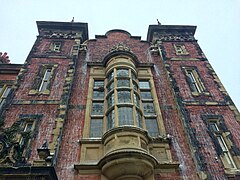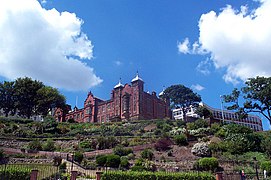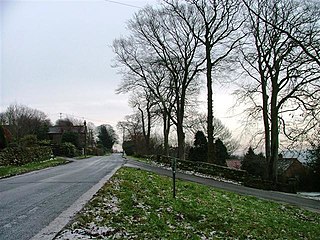
Aislaby is a village and civil parish in the Scarborough district of North Yorkshire, England. It is situated near the town of Whitby on the northern slopes of Eskdale just off the A171.

Morley Town Hall is a municipal facility in Morley, West Yorkshire, England. The town hall, which is the meeting place of Morley Town Council, is a Grade I listed building.

Leeds Town Hall is a 19th-century municipal building on The Headrow, Leeds, West Yorkshire, England. Planned to include law courts, a council chamber, offices, a public hall, and a suite of ceremonial rooms, it was built between 1853 and 1858 to a design by the architect Cuthbert Brodrick. With the building of the Civic Hall in 1933, some of these functions were relocated, and after the construction of the Leeds Crown Court in 1993, the Town Hall now serves mainly as a concert, conference and wedding venue, its offices still used by some council departments. It was designated a Grade I listed building in 1951.

Halifax Town Hall is a grade II* listed, 19th century town hall in the town of Halifax, West Yorkshire, England. It is notable for its design and interiors by Charles Barry and his son, Edward Middleton Barry, and for its sculptures by John Thomas. The town hall is also the headquarters of Calderdale Metropolitan Borough Council.
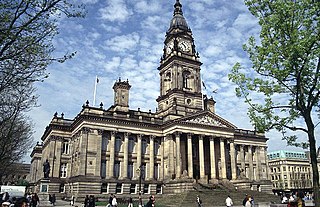
Bolton Town Hall in Victoria Square, Bolton, Greater Manchester, England, was built between 1866 and 1873 for the County Borough of Bolton to designs by William Hill of Leeds and George Woodhouse of Bolton. The town hall was extended in the 1930s to the designs of Bradshaw, Gass and Hope and has been designated a Grade II* listed building by English Heritage.

William Swinden Barber FRIBA, also W. S. Barber or W. Swinden Barber, was an English Gothic Revival and Arts and Crafts architect, specialising in modest but finely furnished Anglican churches, often with crenellated bell-towers. He was based in Brighouse and Halifax in the West Riding of Yorkshire. At least 15 surviving examples of his work are Grade II listed buildings, including his 1875 design for the Victoria Cross at Akroydon, Halifax. An 1864 portrait by David Wilkie Wynfield depicts him in Romantic garb, holding a flower. He served in the Artists Rifles regiment in the 1860s alongside Wynfield and other contemporary artists.

Woolwich Town Hall is an early 20th-century town hall located in the historic Bathway Quarter in the centre of Woolwich, South East London. Until 1965 it was the seat of local government of the Metropolitan Borough of Woolwich, after which it became the headquarters of the Greenwich London Borough Council. It is a rare example of an Edwardian Baroque town hall in London and is a Grade II*-listed building.
Scarborough Convent School, also known as The Convent of the Ladies of Mary Grammar School and many variations, was a girls' school in Scarborough, North Yorkshire, England, from 1882 until 1975.

Croydon Town Hall is a council building in Katherine Street, Croydon which serves as headquarters for Croydon London Borough Council. It is a Grade II listed building.
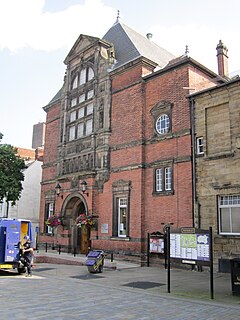
Pontefract Town Hall is a town hall in Pontefract, West Yorkshire, England. It was completed in 1882. It is now owned and used by Wakefield Council as a registry office. The building has been Grade II listed since 15 November 1988.

The Central Tramway Company is an electric-powered funicular railway located in the holiday resort of Scarborough, North Yorkshire. The company has the distinction of being the oldest surviving Tramway Company in the UK, as the original corporation still operates the funicular today. Built in just 6 months between January and August 1881, the Tramway opened on Monday 1 August becoming the 3rd such cliff railway to operate in the borough.

The Old Town Hall is a municipal building in Yorkshire Street, Oldham, England. It is a Grade II listed building.

Ilkley Town Hall, on Station Road, Ilkley, West Yorkshire, is a Grade II listed municipal building designed by William Bakewell of Leeds. It forms the centre of a small complex of public buildings, which also includes Ilkley Library, and the King's Hall & Winter Garden theatre. The library, Town Hall and King’s Hall opened in 1908 opposite Ilkley railway station; the Winter Garden was added to the west in 1914.

Albemarle Baptist Church is a Grade II listed church located on Albemarle Crescent, central Scarborough, North Yorkshire, England. It was designed in the Gothic Revival style by the Bradford architect Henry Francis Lockwood, and opened in 1867.
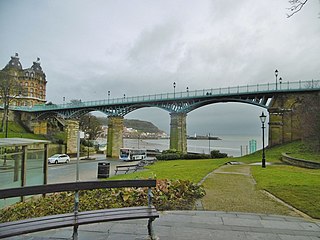
The Cliff Bridge, previously known as the Spa Bridge, is a footbridge in Scarborough, North Yorkshire, England. Spanning the valley from St Nicholas Cliff to The Spa, it was completed in 1827 and is a Grade II listed building.

Colchester Town Hall is a municipal building in the High Street in Colchester, Essex, England. The town hall, which is the headquarters of Colchester Borough Council, is a Grade I listed building.

Bridlington Town Hall is a municipal building in Quay Road, Bridlington, East Riding of Yorkshire, England. The town hall, which was the meeting place of Bridlington Borough Council, is a Grade II listed building.

Cleckheaton Town Hall is a municipal building in Bradford Road, Cleckheaton, West Yorkshire, England. The town hall, which was the headquarters of Spenborough Urban District Council, is a Grade II listed building.

Ossett Town Hall is a municipal building in the Market Place, Ossett, West Yorkshire, England. The town hall, which was the headquarters of Ossett Borough Council is a grade II listed building.
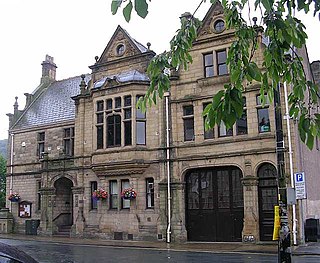
Hebden Bridge Town Hall, formerly Hebden Bridge Council Offices, is a municipal building in St George's Street, Hebden Bridge, West Yorkshire, England. The town hall, which is the meeting place of Hebden Royd Town Council, is a Grade II listed building.



